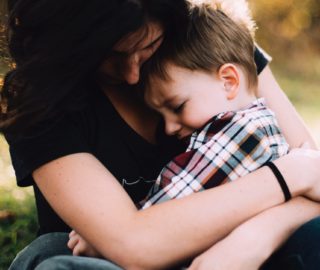About 10% of the U.S. population struggles with drug or alcohol addiction. Addiction is a disease that creates a devastating ripple effect throughout a person’s social circle, and addiction issues cut short lives and cost billions of dollars per year in lost wages and productivity. Drug and alcohol abuse and addiction can be hard to recognize, and it can be equally overwhelming for friends and family to admit that their loved one has a problem.
Guide for Helping a Family Member Suffering from Addiction


Treatment
A Guide for Helping a Family Member with Addiction
People who struggle with addiction will suffer from numerous long term health consequences, lower life satisfaction scores, and lower levels of career achievement. It’s critical that families are equipped with the knowledge, tools, and resources needed to help overcome addiction and drug abuse. The following guide will cover the symptoms of addiction, and how family and loved ones can help an addicted loved one seek treatment.
What are some of the signs of drug or alcohol addiction?
While the symptoms of addiction may differ depending on the substance someone is addicted to, it’s important to recognize the signs of substance abuse early before the addiction becomes worse. Long-term drug abuse and addiction can be harder to treat, although not impossible. The longer a person abuses drugs or alcohol, the more the body and brain become physically and psychologically dependent on the substance. When someone attempts to quit taking the substance, they will experience withdrawal side effects that can be painful, and emotionally distressing.
The signs and symptoms of chronic drug or alcohol abuse share similarities across all substances. The common thread among all symptoms is that the individual’s personality, motivations, and habits all drastically change, and not for the better.
- Sudden or gradual disinterest in school, work, activities, and relationships.
- Poor performance at work or school.
- Failure to perform adequate duties, such as neglecting their children, or financial obligations.
- Unexplained fatigue, or unexplained, sudden bursts of energy.
- Secretiveness, defensiveness, and social isolation.
- Socializing with a different crowd of friends.
- Change in physical appearances, such as a lack of proper grooming or hygiene.
- Financial difficulties, such as running out of money or forgetting to pay bills on time.
- Sudden weight loss or significant weight gain.
- Legal issues.
- Poor physical appearance.
When drug or alcohol abuse is suspected, it’s critical that friends and family act quickly to stop things from getting worse. Alcohol and drug use changes the neural pathways in the brain that are responsible for risk and reward behaviors. Addicts are often in denial about their behavior, and they’ve learned how to function while on drugs or alcohol. The thought of taking away the substance can make them angry, scared, and defensive.
When a loved one is addicted to drugs or alcohol, family and friends can be at a loss of what to do. There are several things that loved ones will commonly do when faced with a family member’s addiction. They may think they are helping their addicted family member, but in actuality, they are making things worse.
What are some of the ways that loved ones think they are helping an addict, but are making the situation worse?
One of the most common mistakes families make in regards to a loved one’s addiction is enabling the behavior. Sometimes, family members don’t even realize they are doing this. Often, family members don’t fully understand the extent of the issue and may fear they are overreacting. When the addict is an older family member, such as a parent, it can be especially difficult for the child to confront their parent about drug abuse. But if family members are noticing that the addict is experiencing problems directly related to substance abuse, then the family is not overreacting.
If someone continues to use drugs or alcohol despite the consequences, that is an indicator of a significant problem, and family members are not wrong to be concerned. If the family fails to address the issue and instead continues to ignore the problem, then they are making the addiction more important than the problems it is causing.
One of the most effective ways to help an addicted loved one realize that they have an issue with drugs or alcohol is to allow them to experience the full consequences of their actions. Family and friends often make the mistake of cleaning up after the addict.
For example, alcohol and drug use will frequently impair a user’s memory, and loved ones may find themselves agreeing with the user’s version of events, even if they know those events aren’t true. Other prime examples of enabling behavior include:
- Agreeing with the loved one that their drinking or alcohol use isn’t “that bad.”
- Covering up their behavior, or making excuses for them.
- Buying drugs or alcohol for them.
- Giving them money if they experience financial difficulties related to their drug use.
- Giving them a place to live if they become homeless as a result of addiction.
- Having difficulty expressing concerns and fears over addictive behavior.
- Fearing an addict’s reaction if they were to stop enabling the behavior.
- Blaming other people or situations instead of the addict for negative consequences related to abuse.
- Resenting the addict but continuing to engage in enabling behavior.
For loved ones, admitting that their family member is suffering from addiction can be painful, scary, and stressful. But denying, covering up, and making excuses for the addict only prolongs the behavior, and will lead to worse outcomes than if the issue were to be addressed and dealt with swiftly. Regardless of whether the addicted family member is a parent, child, or a sibling, it’s crucial to recognize addiction and stop the cycle of enabling behavior.
What can family members do to stop enabling, but empower their loved one to seek treatment instead?
Family members often realize they need to stop engaging in enabling behavior, but they are too afraid to do so. Unfortunately, drug and alcohol addiction can make an otherwise gentle person irrationally angry, and they may lash out at family members or friends in abusive ways when they stop trying to enable the addict.
It’s vital that family members weigh the pros and cons associated with helping an addicted loved one through enabling behavior. They should ask themselves if cleaning up after the addict one more time will help them in the long run, or prevent them from seeking treatment?
It’s crucial that family members have outside support in place when they attempt to stop enabling behaviors. Reaching out to a professional addiction interventionist can give them the tools and resources necessary to put safeguards in place and help their loved one realize that the drug or alcohol abuse needs to stop.
Some of the ways family and friends can stop enabling their addicted loved one is to:
- Stop cleaning up after the loved one. That includes giving them money or paying off their legal fees.
- Take back their autonomy. Addicts often put family members in situations that can be dangerous for everyone involved. Family and friends need to find practical ways to prevent the addict from continuing to involve others in these types of potentially hazardous situations.
- Follow through with their plans. Again, it’s critical to have support in place. Stopping enabling behavior will often be met with resistance from the addict. It can be difficult for family members to hold their resolve and follow through with their plans if they do not have outside support.
Is there a way to avoid making a loved one angry, while still empowering them to seek help and stop enabling behaviors?
When confronting a loved one about their addictive behavior, emotions on both sides of the issue can quickly become heated, and conversations can spiral out of control. It’s essential to avoid “blaming” language, or accusations. But for loved ones who’ve been enabling an addict for a long time, this can be especially difficult. Sometimes, writing a letter to the addicted loved one can prevent anger from boiling over.
Composing an intervention letter gives family members time to get the tone right. For the addict, reading a letter can provide them with time to process their emotions, and it can seem less confrontational.
When writing an intervention letter, it’s vital to come from a place of love and concern, not anger and blame. It’s all right to express negative emotions in the letter, but it’s important to do so in a non-confrontational tone. The point of the letter is to help the loved one accept that enabling behavior is going to stop and that their addiction has gotten out of control and they need help.
- Begin the letter with a statement of love.
- Give a specific example of how their addiction has affected you, and what you will do to stop enabling behavior.
- Demonstrate that you understand that their addiction is a disease.
- Repeat the statement of love and concern.
- Close the intervention letter by asking them to seek treatment for addiction.
Once an addicted loved one understands that they need medical intervention, the next step is to get them to a medical detox and rehab facility for treatment. If your loved one is struggling with abuse and addiction, please reach out a drug abuse counselor today for support. They can help you stage an intervention and get your loved one and family the treatment they need to overcome drug addiction and stop the cycle of abuse.




